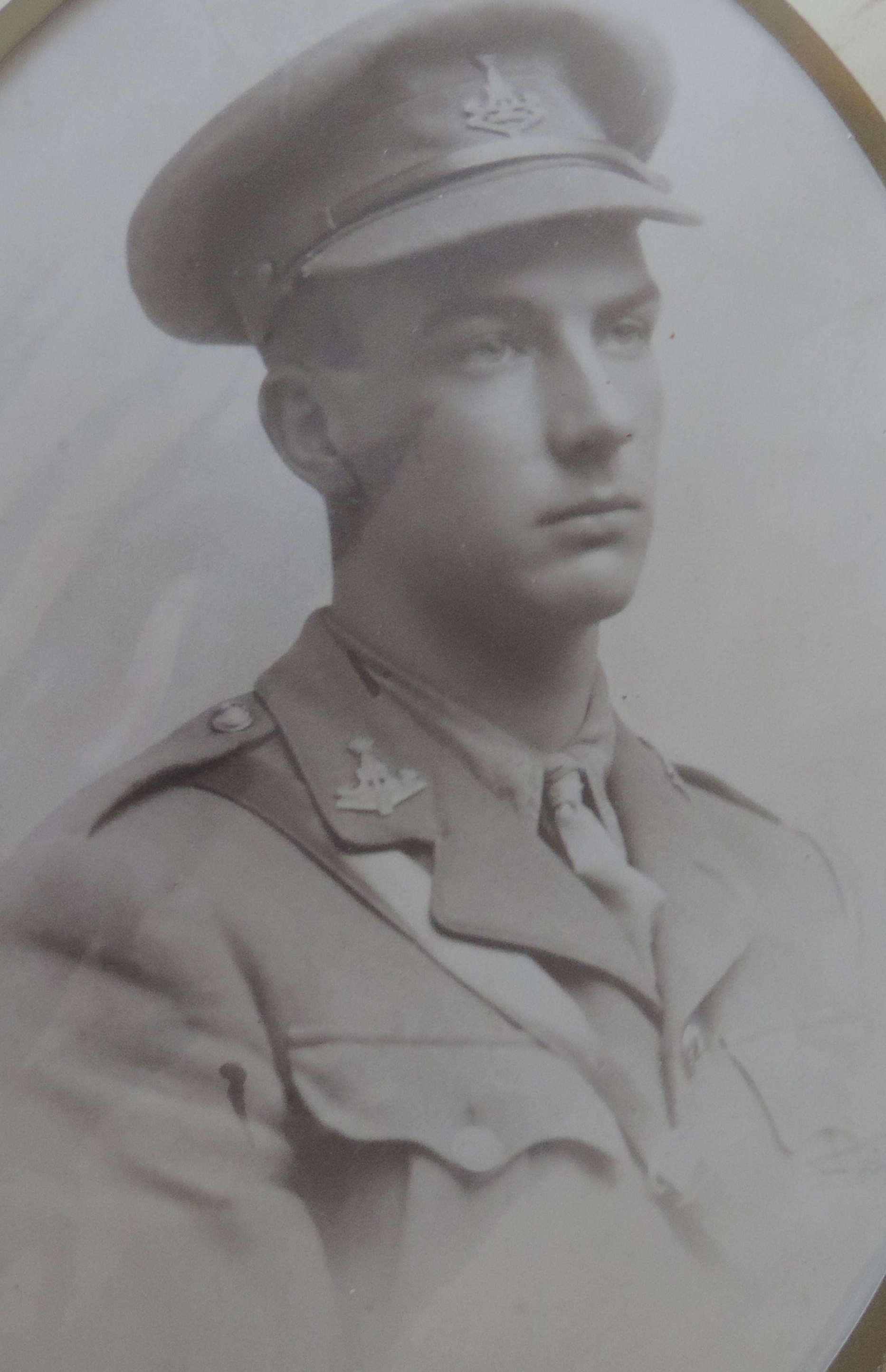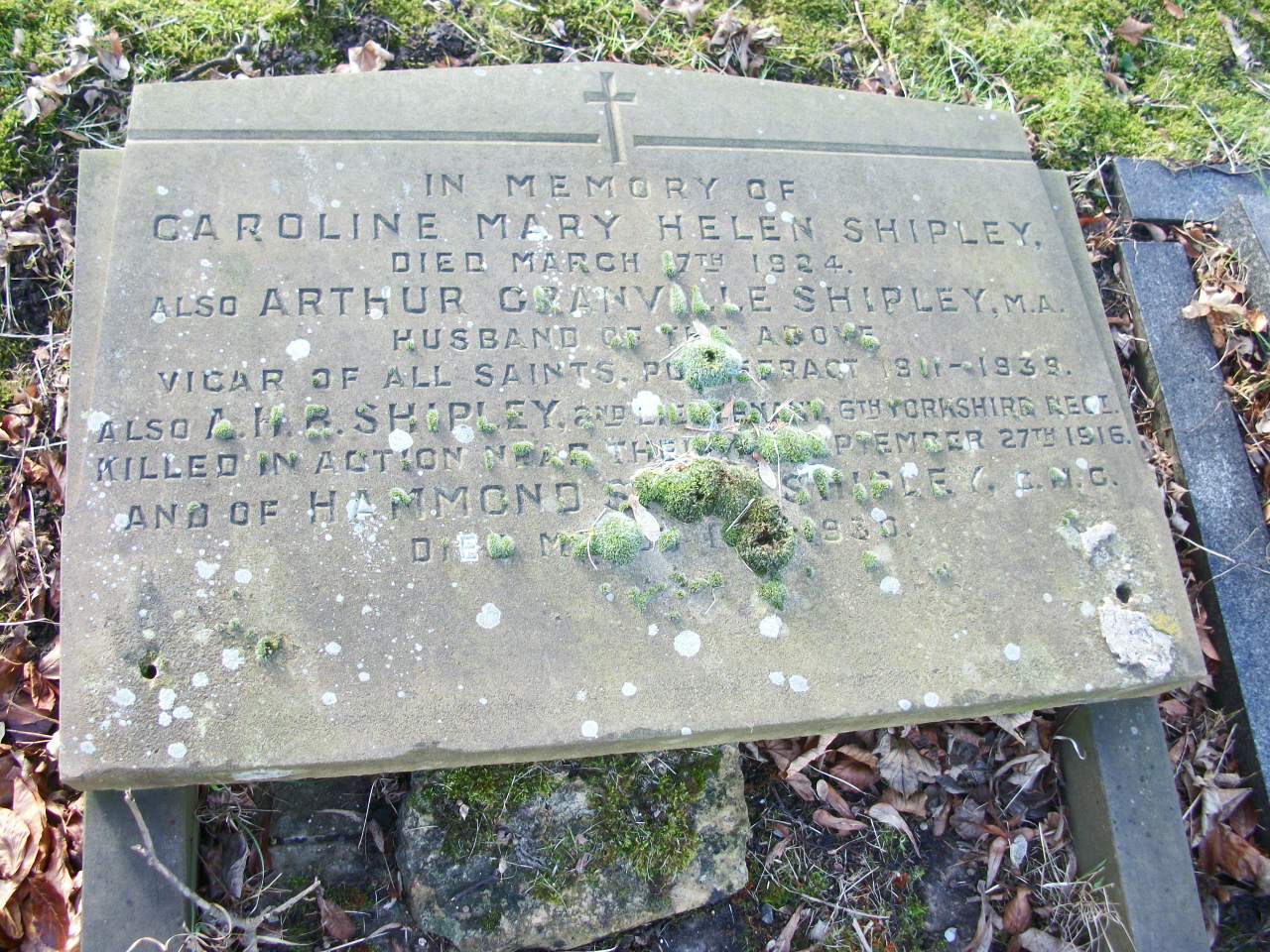Arthur Hammond Butler Shipley
Date of birth: 26.8.1895
Date of death: 27.9.1916
Area: Pontefract
Regiment: Yorkshire
Family information: Only son of Reverend Arthur Granville Shipley and Caroline Mary Ellen Butler
Rank: Private
Service number: 4244
War Service
Before he could start university life in autumn 1914, war broke out. He joined up at Derby on 4 September 1914. As he could not ride he opted for the Infantry. He joined the 21st Service Battalion of the Royal Fusiliers as a Private, Regimental number 4244. On 28 November 1914 he was commissioned as a temporary Second Lieutenant in the 7th Battalion of the Yorkshire Regiment.
His papers reveal that on enlistment, at just over 19 years of age, he was five feet eleven inches tall, weighed 164 pounds and had a chest measurement of 37 1/2 inches. He was adjudged in good physical shape. He had brown hair and blue eyes.
After training, he went with the 6th battalion of the Yorkshire Regiment to the Dardanelles in July 1915, participating in that ill-fated attempt to outflank the enemy on the eastern front. He was hospitalised in autumn 1915 suffering from septic poisoning. As is the case for the majority of WW1 servicemen, there are no records left to tell us how long he was out of action and if he was wounded. The battalion was evacuated to Alexandria February 1916 owing to severe casualties, disease and the harsh weather. It took over duties defending the Suez Canal.
In June 1916 the battalion was attached to the 11th Division in France. Young Arthur was in A Company. He was involved in the battle for Thiepval Ridge, a key moment in the terrible struggle at the Somme. On 27 September 1916 he was killed in action. He was one month past his 21st birthday, coming into his inheritance from his grandmother. His parents feared the worst when his regular letters stopped coming.
His death is commemorated on the Thiepval Memorial and at Haileybury. His father ordered that his son's name should be included on his own headstone in Pontefract Cemetery, together with those of his wife and brother, when he died in 1959. His will also asked Pontefract Corporation to maintain the memorial offering them a bequest of £75 for this purpose. The memorial could use some tender loving care today. I suspect that the Corporation accepted neither this duty nor the money.
We can only guess at the effect of his death on his parents. His mother's obituary in the Pontefract and Castleford Express in 1924 reads that she never recovered from the death of her son. I suspect this is reflected in the sharp tone of some of the letters his father wrote to the War Office from October 1916 to January 1917 to recover his effects. One letter notes that Young Arthur never returned home - to the vicarage in Pontefract where he would have had a bedroom and his possessions - from the time he embarked to the Dardanelles. He went through the Gallipoli campaign, septic poisoning, and then the carnage at the Somme.
I do not know what the Commanding Officer wrote to Young Arthur's father about how he died. Many bodies at the Somme were not recovered and remains never identified. I found it poignant reading Young Arthur's War Office file at the National Archives. One detail sticks in my mind - that found among his effects was a book, a copy of Hamlet.
This is a time when we are remembering the lives and deaths of those caught up in the First World War. In the case of young Arthur, he has no descendants or close family left. I am a half first cousin of his father's three times removed, because my great-great-great-grandmother remarried to John Shipley, young Arthur's great-grandfather. No-one could have imagined that when this promising young man left school in summer 1914 he would never take up his place and Exhibition at Peterhouse and would predecease not only his father but also his grandfather Hammond Shipley, whose death in Nottingham was witnessed by young Arthur's father in 1919 at over 84 years, four times the age Young Arthur reached.
Family Life
He was born on 26 August 1895 in Ledbury Hertfordshire. He was the only child of Reverend Arthur Granville Shipley and Caroline Mary Ellen Butler. His parents had married in 1893 when Caroline was 36 years old (her husband was ten years younger).
Young Arthur - I heard from a relative who knew his father that he was so called in the family - would have been all the more precious for being an only child, in an age when large families were common. His paternal grandmother Catherine Shipley left him property in Shepshed Leicestershire in her will of 1911: he was the person to carry on the Shipley family line and success. His name reflected this. His first Christian name (Arthur) was his father's; the second (Hammond) was his grandfather Shipley's, great-grandfather Shipley's and his uncle's Christian name; his third (Butler) was his mother's family name. The hopes of many were wrapped up in his future.
His father was an energetic Anglican clergyman, from 1911 until 1939 Vicar of All Saints' Pontefract under Pontefract Castle - the longest-serving vicar in the long history of that church, who was given the Freedom of the Borough of Pontefract in 1956 for his contribution to the parish, to local schools and local committees. His father had one sibling - a brother, Hammond Smith Shipley - who spent over 35 years working for the Foreign Office in the Ottoman Empire and Persia. H S Shipley was personally congratulated by Foreign Secretary Lord Salisbury and made a Companion of the Most Distinguished Order of St Michael and St George (CMG) for his work as British delegate attached to the Sassoun Commission in 1895 investigating atrocities against Armenians.
Young Arthur's mother was a retiring person who focussed on family life. Her father had been an Anglican clergyman too in Leicestershire. One of her brothers, Alfred Joshua Butler, was a celebrated fellow at Brasenose College Oxford, one time curator of the Ashmolean Museum and author of several books. He championed the cause of the Copts in Egypt.
In 1909 Young Arthur went to Haileybury School. He was awarded colours for Hailey House, playing both rugby and cricket. This carried on the sporting tradition of his father and uncle Hammond. In cricket, the matches for which there are scores available show that his House suffered some heavy defeats though he made a good contribution especially as a bowler. He was a Prefect. In January 1914, he won a scholarship to Peterhouse College Cambridge. He left school that summer.
 Arthur H B Shipley
Arthur H B Shipley
 The headstone in Pontefract Cemetery
The headstone in Pontefract Cemetery

